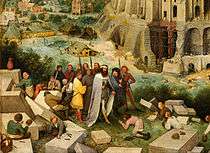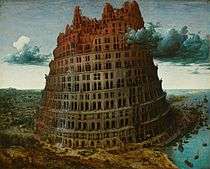The Tower of Babel (Bruegel)
_-_Google_Art_Project_-_edited.jpg) | |
| Artist | Pieter Bruegel the Elder |
|---|---|
| Year | c. 1563 |
| Medium | oil on panel |
| Dimensions | 114 cm × 155 cm (45 in × 61 in) |
| Location | Kunsthistorisches Museum, Vienna |
_-_Google_Art_Project.jpg) | |
| Artist | Pieter Bruegel the Elder |
|---|---|
| Year | c. 1563 |
| Medium | oil on panel |
| Dimensions | 60 cm × 74.5 cm (24 in × 29.3 in) |
| Location | Museum Boijmans Van Beuningen, Rotterdam |
The Tower of Babel is the subject of three oil paintings by Pieter Bruegel the Elder. The first, a miniature painted on ivory, was painted while Bruegel was in Rome and is now lost.[1] The two surviving paintings depict the construction of the Tower of Babel, which according to the Book of Genesis in the Bible, was a tower built by a unified, monolingual humanity as a mark of their achievement and to prevent them from scattering: "Then they said, 'Come, let us build ourselves a city, and a tower with its top in the heavens, and let us make a name for ourselves; otherwise we shall be scattered abroad upon the face of the whole earth.'" (Genesis 11:4). The person in the foreground is likely Nimrod, who was said to have ordered the construction of the Tower.[2]
History and description
Bruegel's depiction of the architecture of the tower, with its numerous arches and other examples of Roman engineering, is deliberately reminiscent of the Roman Colosseum,[3] which Christians of the time saw as both a symbol of hubris and persecution. Bruegel had visited Rome in 1552–1553. Back in Antwerp, he may have refreshed his memory of Rome with a series of engravings of the principal landmarks of the city made by the publisher of his own prints, Hieronymous Cock, for he incorporated details of Rooster's Roman engravings in both surviving versions of the Tower of Babel with few significant alterations.compare 2nd image below The parallel of Rome and Babylon had a particular significance for Bruegel's contemporaries: Rome was the Eternal City, intended by the Caesars to last forever, and its decay and ruin were taken to symbolize the vanity and transience of earthly efforts.[2] The Tower was also symbolic of the turmoil between the Catholic church (which at the time conducted all services in Latin) and the polyglot Lutheran Protestant religion of the Netherlands.[4] Although at first glance the tower appears to be a stable series of concentric pillars, upon closer examination it is apparent that none of the layers lies at a true horizontal. Rather the tower is built as an ascending spiral.
The workers in the painting have built the arches perpendicular to the slanted ground, thereby making them unstable and a few arches can already be seen crumbling. The foundation and bottom layers of the tower had not been completed before the higher layers were constructed. Lucas van Valckenborch, a contemporary of Bruegel's, also painted the Tower of Babel in the 1560s and later in his career, possibly after seeing Bruegel's depiction.[2] Both were part of a larger tradition of painting the tower during the 16th and 17th centuries.[5] The influence of Northern artists can be seen in the careful attention Bruegel paid to the painting of the landscape.[6]
_-_Google_Art_Project.jpg)
The story of the Tower of Babel (like that The Suicide of Saul) was interpreted as an example of pride punished, and that is no doubt what Bruegel intended his painting to illustrate. Moreover, the hectic activity of the engineers, masons and workmen points to a second moral: the futility of much human endeavour. Nimrod's doomed building was used to illustrate this meaning in Sebastian Brant's Ship of Fools[7] Bruegel's knowledge of building procedures and techniques is considerable and correct in detail.compare 3rd image The skill with which he has shown these activities recalls that his very last commission, left unfinished at his death, was for a series of documentary paintings recording the digging of a canal linking Brussels and Antwerp.[8]
The Tower of Babel is on display at the Kunsthistorisches Museum, Vienna. Another painting of the same subject The "Little" Tower of Babel, c. 1563, is in the Museum Boijmans Van Beuningen in Rotterdam.
In popular culture
The painting appears as the main element on one box art design of the video game Civilization III.
They are briefly mentioned in Shadowman, where Jaunty explains that Bruegel was shocked at how The Asylum resembled his paintings.
The painting also makes an appearance in the 2012 video game, Call of Duty: Black Ops 2, in the zombie survival mode in the map, 'Green Run' on a wall in a section of the map (Town).
 | |
|
|
 | |
|
|
See also
References
- ↑ Morra, Joanne (2007). "Utopia Lost: Allegory, Ruins and Pieter Bruegel's Towers of Babel". Art History. 30 (2): 200. doi:10.1111/j.1467-8365.2007.00538.x.
- 1 2 3 "The Tower of Babel". Art and the Bible. Retrieved July 15, 2011.
- ↑ Malam, John (1999). Pieter Bruegel. Carolrhoda Books. p. 15. ISBN 1-57505-366-7.
- ↑ Morra, 202
- ↑ West, Andrew. "72 More Views of the Tower of Babel". BabelStone. Retrieved July 15, 2011.
- ↑ Pietro Allegretti, Brueghel, Skira, Milano 2003, s.v. "Torre di Babele". ISBN 0-00-001088-X (Italian)
- ↑ This book's online text may be viewed at The Ship of Fools, Project Gutenberg. See also article by N. Collins, on Encyclopedia of Art Education Accessed 4 February 2012
- ↑ P. Allegretti, ibid.
- ↑ "Bruegel's Tower of Babel". Smarthistory at Khan Academy. Retrieved March 12, 2013.
- ↑ "The "Little" Tower of Babel". ARTtube. Retrieved March 19, 2013.
Further reading
Orenstein, Nadine M., ed. (2001). Pieter Bruegel the Elder: Drawings and Prints. The Metropolitan Museum of Art. ISBN 9780870999901. (fig. 5)
External links
| Wikimedia Commons has media related to The Tower of Babel by Pieter Bruegel the Elder. |
